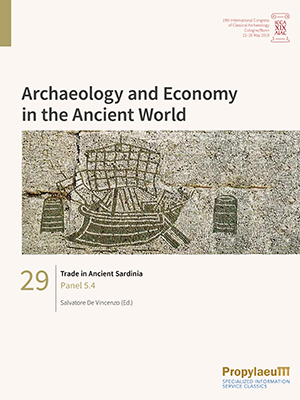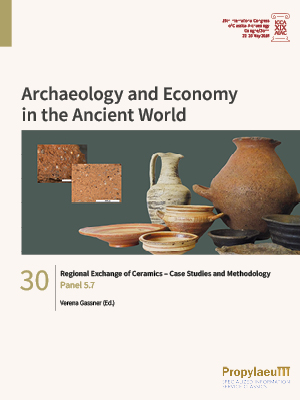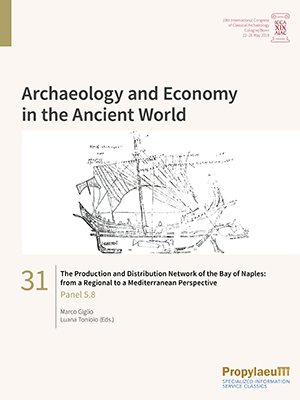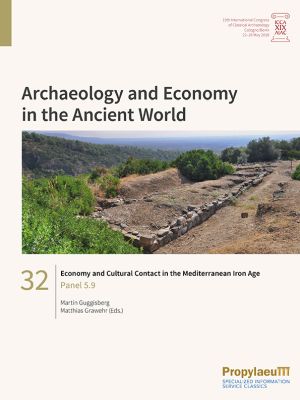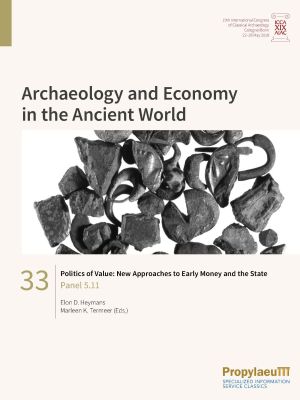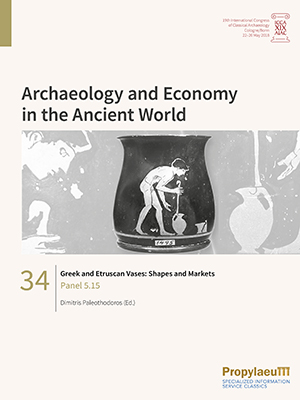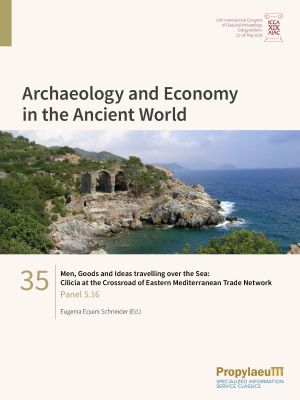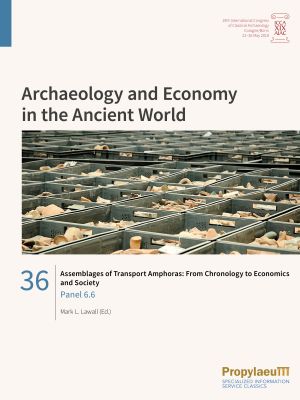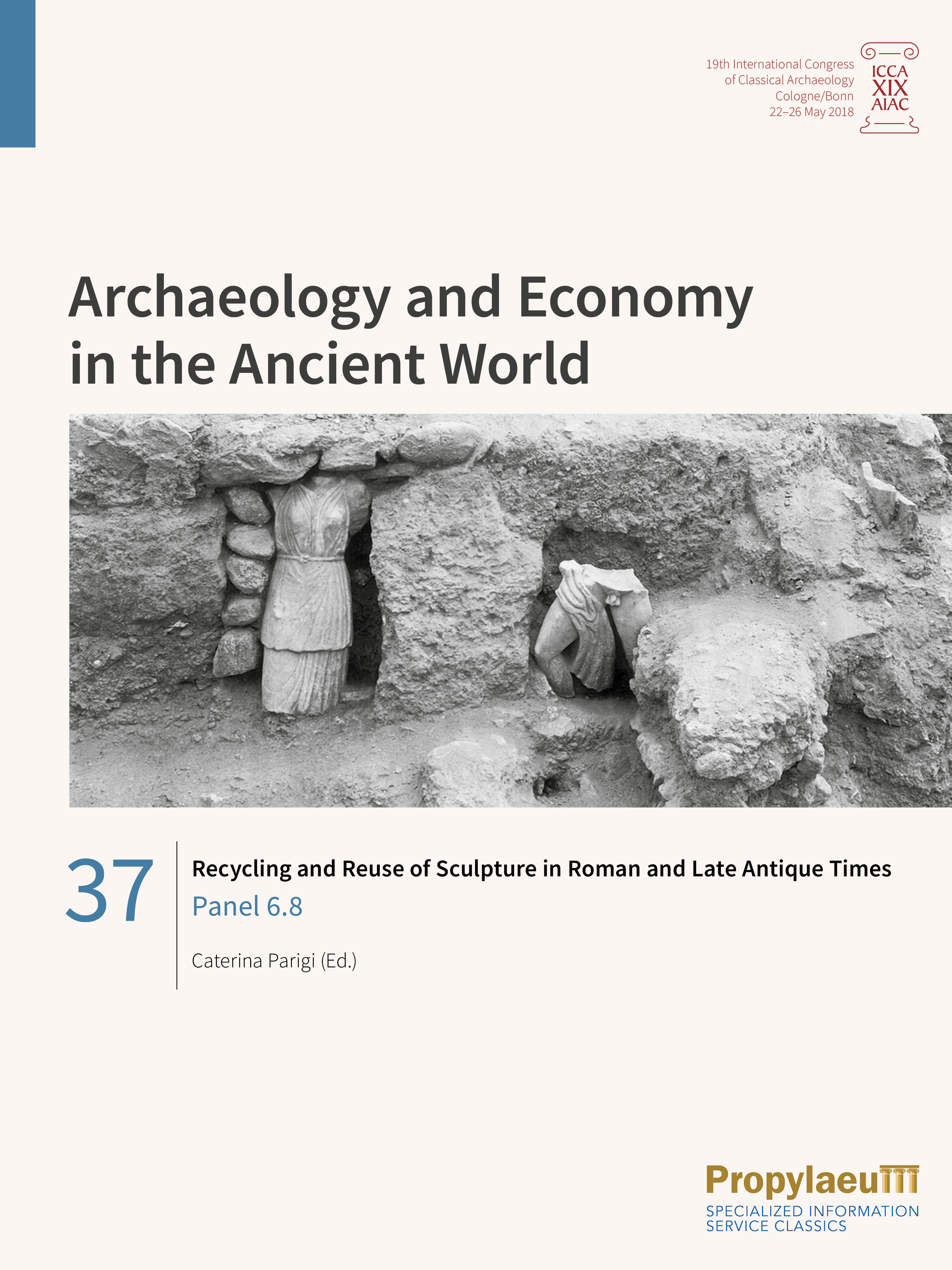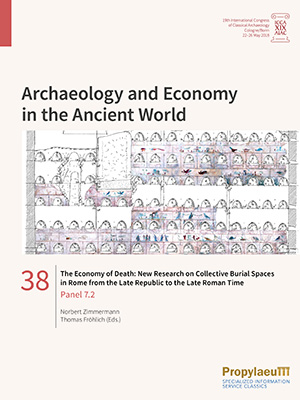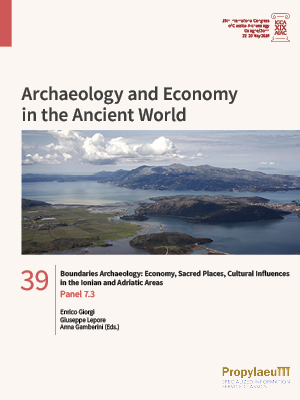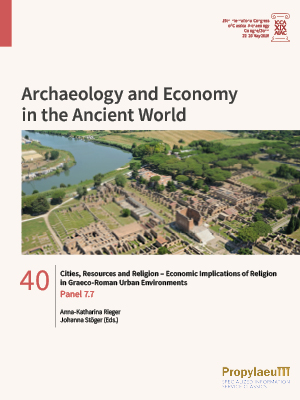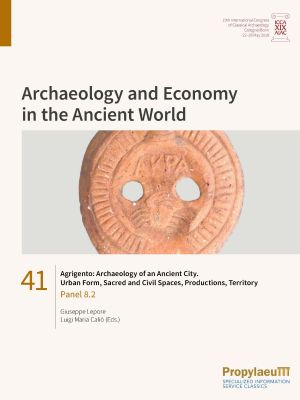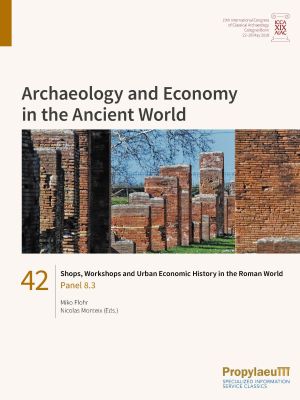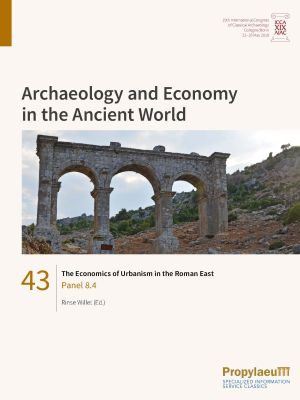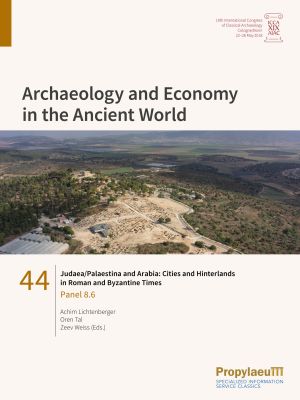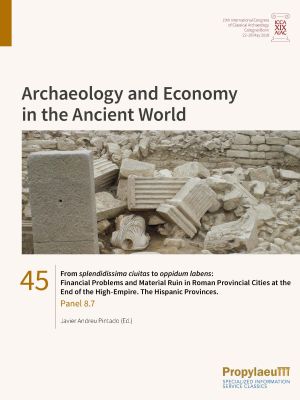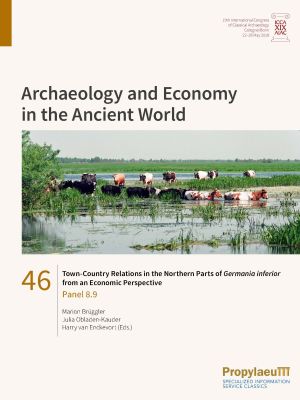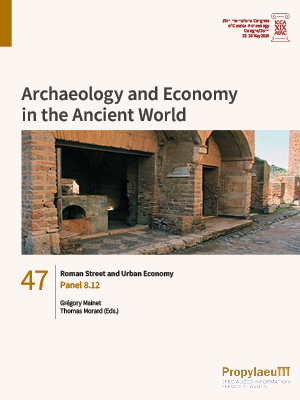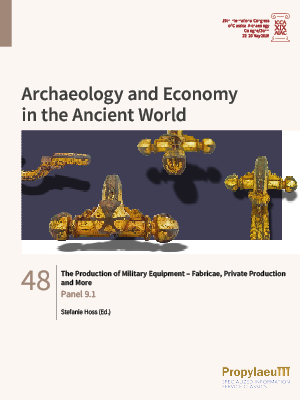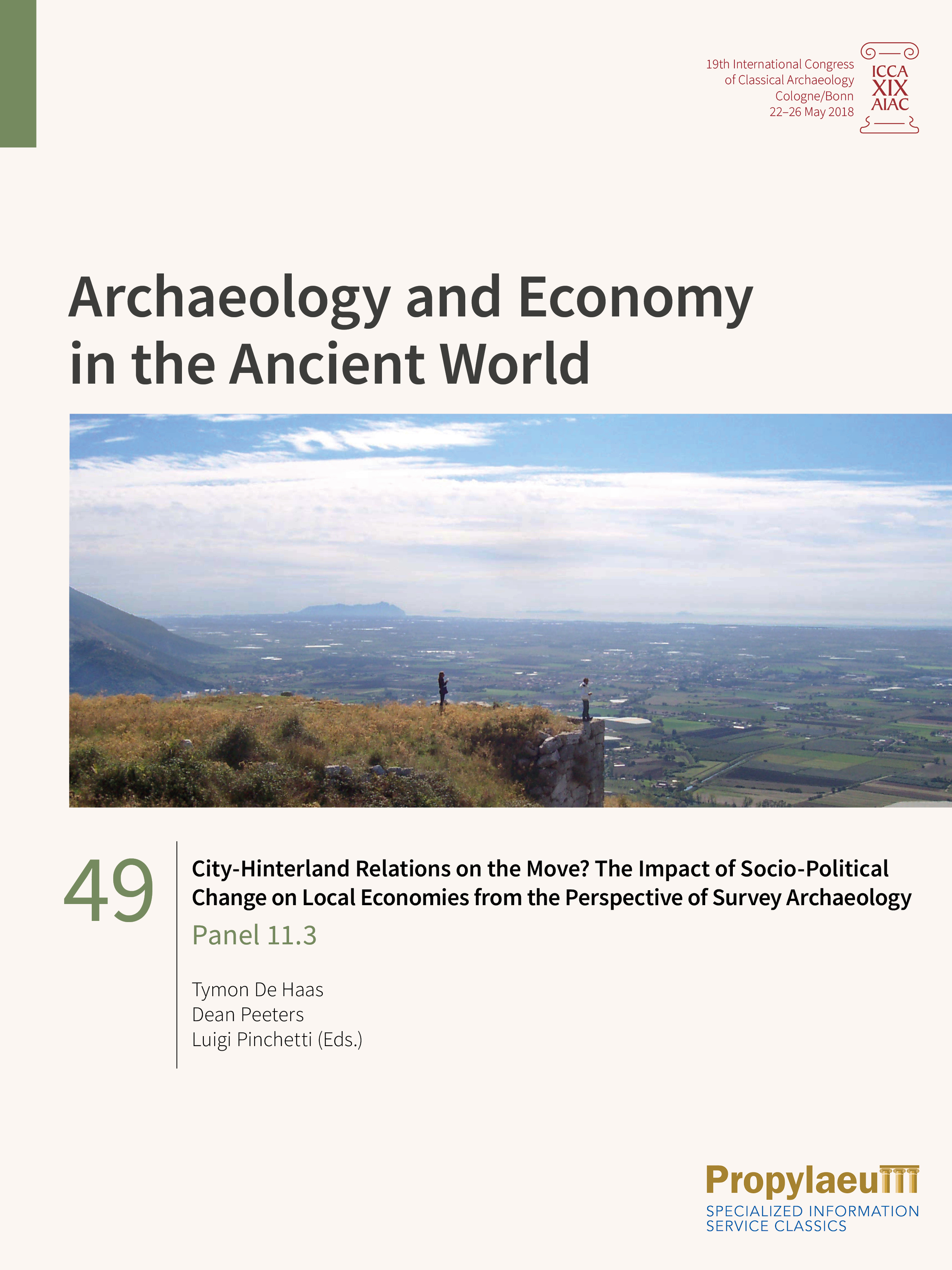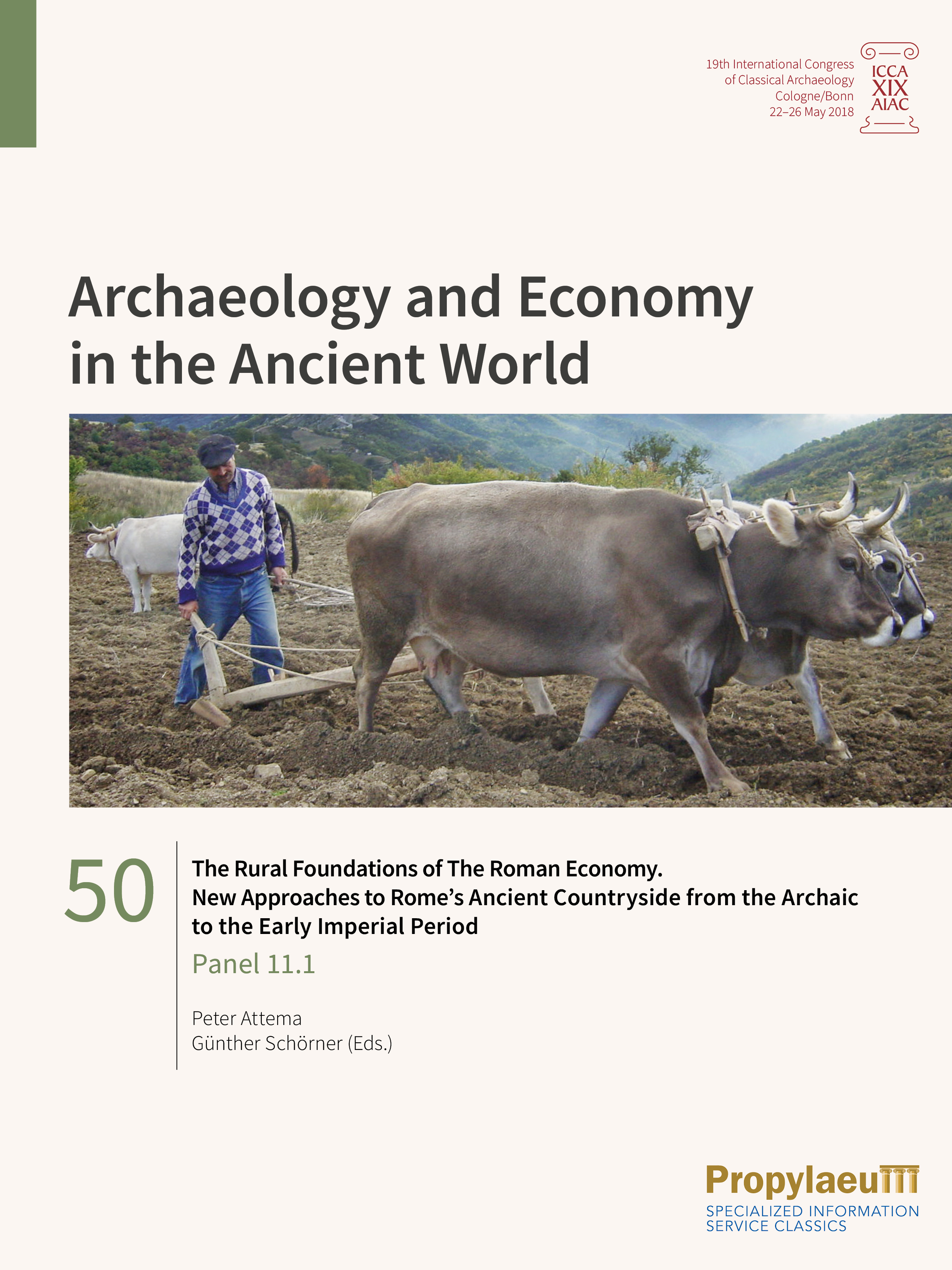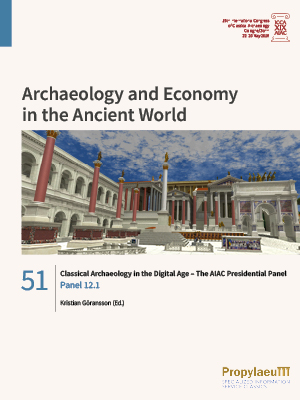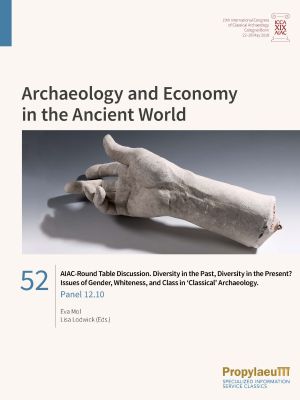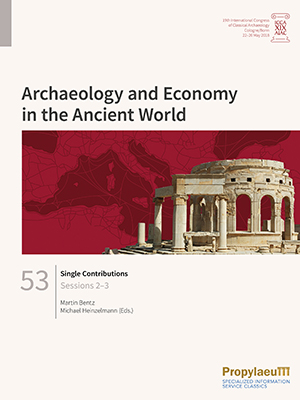Archaeology and Economy in the Ancient World
Proceedings of the 19th International Congress of Classical Archaeology, Cologne/Bonn 2018
These volumes form the final publication of the 19th International Congress of Classical Archaeology, which was held from 22 to 26 May 2018 in Cologne and Bonn on behalf of the 'Associazione Internazionale di Archaeologica Classica (AIAC)'. Under the title 'Archaeology and Economy in the Ancient World' more than 900 presentations, divided into 11 sections and 128 panels, dealt with various aspects of ancient economic history.
In fact, economic aspects permeate all areas of public and private life in ancient societies, whether in urban development, religion, art, housing, or in death. Research on ancient economies has long played a significant role in ancient history. Increasingly in the last decades, awareness has grown in archaeology that the material culture of ancient societies offers excellent opportunities for studying the structure, performance, and dynamics of ancient economic systems and economic processes. Therefore, the main objective of this congress was to understand economy as a central element of classical societies and to analyse its interaction with ecological, political, social, religious, and cultural backgrounds. The theme of the congress was addressed to all disciplines that deal with Greco-Roman civilization and their neighbouring cultures from the Aegean Bronze Age to the end of Late Antiquity.
In the present series, numerous panels are presented as independent thematic volumes (Volumes 1–52). The further contributions are compiled in four collective volumes (Volumes 53–56).
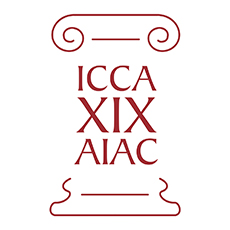
Editors
Prof. Dr. Martin Bentz
Institut für Archäologie und Kulturanthropologie
Universität Bonn
Prof. Dr. Michael Heinzelmann
Archäologisches Institut
Universität zu Köln
Internet: 19. ICCA 2018
Email: congress.aiac2018@uni-bonn.de
Published so far
Trade in Ancient Sardinia: Panel 5.4
The themes of this panel are the modes of trade in ancient Sardinia. What are the trade routes touching ancient Sardinia? Which areas and cities in Sardinia were most involved in these exchanges? Which products were exchanged and how was the island's production affected by trade? Which patterns are observable in importing and imitating foreign goods, which were carried to the island by traders? How do these aspects change over time, from Archaic times to Late Antiquity?
This analysis on ancient trade in Sardinia will be carried out predominantly based on pottery contexts. But of course, other trade goods like iron ore, of which Sardinia possessed great amounts, thereby shaping trade routes from the first millennium BC onwards, will be taken into account as well. The chronological phases in question range from Archaic times to Late Antiquity, comprising transactions of indigenous people, Carthaginians, and Greeks, with particular regard to the trade in the Roman era.
Regional exchange of ceramics – case studies and methodology: Panel 5.7
Pottery vessels and other ceramic objects constitute important sources for issues of trade and exchange in Antique societies as they are available in great quantities and as their provenance often can be determined by archaeological or archaeometric methods. Most studies on the exchange of ceramics however concentrate on aspects of long-distance trade, as differences between wares and/ or types produced in different, far distant regions can be recognized more easily. This fact, together with the psychological fact of the greater attractiveness of these items, might have lead to an exaggerated perception of the amount of goods traded via the oversea trade in the archaeological record. In contrast to this, aspects of regional exchange between neighbouring cities have not been given the same attention in the field of Mediterranean archaeology, although they might give important insights into the problems of regional connectivity and they also had greater importance during Antiquity than normally assumed. One of the reasons of this deficit can certainly be found in the difficulty of clearly and unambiguously distinguishing ceramics produced within one r egion f rom e ach other, a s t hey o ften s hare the s ame repertory of shapes or decoration styles.
This panel comprises case studies from different areas and different periods of the Mediterranean, all of which clearly demonstrate the difficulties in reconstructing networks of regional exchange, but also show their importance for the economy of ancient towns.
The Production and Distribution Network of the Bay of Naples: from a Regional to a Mediterranean Perspective: Panel 5.8
Recent excavations on both production and consumption sites in Campania and international conferences on Roman pottery have given new impulses to the research on material culture and the regional and international pottery trade systems.
This volume analyses the circulation of pottery produced in the Bay of Naples between the late Republican and the early Imperial period from a double perspective: on one side the networks that transported pottery from the Bay to various points along the Mediterranean littoral; and on the other side the foods coming to Naples from various points in the Mediterranean.
The excavation contexts of Piazza Municipio in Naples, Puteoli and Herculaneum provide new relevant datasets both from the qualitative and quantitative point of view. This evidence highlights the strong relations of this area with the Eastern Mediterranean, especially in fine wares and transport containers - from the 2nd century BC Rhodian wine amphorai to 1st century AD Cretan products.
The area of the Magdalensberg imported Campanian Internal Red Slip ware as early as the late Republican period, and in especially high amounts in the Augustan age, when Campanian cooking wares are also attested in Aquileia, in northern Italy, the hotspot for the distribution of these vessels to the provinces of Northern Europe.
Economy and Cultural Contact in the Mediterranean Iron Age: Panel 5.9
The economy has always been a driving force for cultural contact. Analyzing the economic connections within the Ancient World can provide a promising basis for studying intercultural connections. The Iron Age is a period of increasing inter-connectivity between different 'cultures' in the Mediterranean and it offers the fascinating possibility of studying an emerging economic and cultural system. Where did the new routes pass through that the people moved and shifted commodities along? How did the emerging demand on foreign markets influence production patterns and social structure within the local communities? How did local customs react to foreign commodities and how did such imports shape local culture? This volume is a collection of papers that focus on the 8th–6th century BC. Long object biographies are meticulously reconstructed and analyzed through up-to-date methodology to provide answers on production modes, trade routes, and consumption. Debating resources, commodities, and the reception of foreign products, the volume offers new details and insights to further our understanding of the role played by the economy in cultural contacts.
Politics of Value: New Approaches to Early Money and the State: Panel 5.11
As one of the most enduring icons of economic life, money has been a common feature and central focus in complex societies from Antiquity to the present. It gained weight as a key feature of Mediterranean economies in the course of the first millennium BCE, mostly in the form of coinage. But money is more than just coin, and its significance is more pervasive than just to the strict sphere of “the economy”.
In the ancient Mediterranean, money and its rise to prominence have b een p redominantly a ssociated w ith t he s tate. B ut c an money only emerge under state authority? This volume questions the assumed relation between the spread of early forms of money and the state and draws attention to different ways in which money as an innovation could be anchored and socially embedded.
Greek and Etruscan Vases: Shapes and Markets: Panel 5.15
The eight essays published in this volume address topics relating to the production, consumption and trade of painted pottery in the Ancient Mediterranean World, during the Archaic and Classical periods, with special emphasis on the Italian Peninsula, Greece and the Balkans. Important questions on the use, function and role of vases at a broader social or religious level have also been taken into account, by focusing on the response of individual clients to both imports and local vases, or by examining specific shapes traded in both the home market and overseas. Another goal attempted, and to a large extent fulfilled, was to present fresh material, newly excavated or recently studied. Above all, our aim was to present original studies that may be considered valuable contributions in vase scholarship.
Men, Goods and Ideas Travelling over the Sea. Cilicia at the Crossroad of Eastern Mediterranean Trade Network: Panel 5.16
Thanks to its specific geographical position, at the crossroads of the most important sea and land trading routes, in a necessary point of transition and interconnection between Syria, Cyprus and Egypt, Cilicia has always played a distinctive role within the context of cultural, social and commercial exchanges in the Mediterranean area. In particular during its Romanisation, the commercial relations with the various areas of the Empire were of fundamental importance, and particularly the relations with the Eastern Mediterranean, which were substantial, and were constantly maintained until the first Byzantine age. The subject of this panel was an assessment of the present knowledge on this region, focusing on integrated studies on production exchanges, trade and transport in the Mediterranean. Underwater research, archaeological and geophysical investigation about harbour basins, the study of production facilities, analysis of material culture and numismatic evidence have led and are still leading to an exhaustive picture of the changes and transformations involving the region and the urban centres throughout centuries as a result of evolving large-scale economic and social processes. The resulting large amount of information about the role played by the region as a production centre and a market-place has created comparative samples for other research under way in Cilicia and south-eastern Turkey.
Assemblages of Transport Amphoras: From Chronology to Economics and Society: Panel 6.6
Wherever they end up in the archaeological record and however they were used from initial potting to final discard, transport amphoras are artifacts of economic activity. That connection to the ancient economy, however, does not limit the range of archaeological contexts where amphoras played a significant role.
The papers in this volume examine a wide range of settings – from individual buildings to shipwrecked cargoes to broad geographic regions – where these jars are found. While find spots are oft en analyzed for whatever chronological evidence they might provide, contexts – broadly defined – can also contribute to more complex social and economic interpretations of the jars and the areas where they appear. Hence, in this volume, amphoras are studied in terms of supplies to sanctuaries and other public functions, artifacts of private commercial business, localized demand for different kinds of products, broad commercial trends shaped by Mediterranean geopolitics and environmental change. The authors cover finds from Archaic Didyma, Classical Corinth, the late Classical shipwreck near Mazotos (Cyprus), Hellenistic Rhodes and Ephesos, and the sites of Voura and Aigio on the north coast of the Peloponnese. These studies highlight the many different ways that inherently economic artifacts inform our understanding of ancient society.
Recycling and Reuse of Sculpture in Roman and Late Antique Times: Panel 6.8
Recycling and reuse of sculpture was a common practice in the ancient world, which took a variety of forms in different periods and places.
The volume stresses two main aspects in relationship to this practice, namely the reuse of sculptures and their parts as building material on the one hand and in their original function or as works of art on the other hand.
The reuse of sculpture has a number of socio-economical aspects. As the economic factor always plays an important role in recycling, it must always be taken into account. It is also important to remember the difficulty to purchase new sculptures in Late Antiquity. However, reuse and recycling are complex processes, which do not have a single cause and not only occur in Late Antiquity. The reuse of statues may also have had an aesthetic value and been seen as a reminder of former times of glory.
This volume focuses on the Roman and Late Antique periods, aiming to show the continuity and the complexity of the phenomenon. Through the comparison of different case studies in varying contexts, the papers highlight the common features and local singularities of this practice.
The Economy of Death: New Research on Collective Burial Spaces in Rome from the Late Republic to the Late Roman Time: Panel 7.2
The contributions of this volume study economic aspects of Roman burial architectures for extended numbers of burials, such as columbaria, large hypogea, or catacombs, and try to form a picture of their owners and users. They discuss how far economic reasons played a leading role in the invention, the development and the use of these big burial monuments in Rome and how these buildings fulfilled the religious and social needs of their users, especially in the transitional period from the Roman to the Early Christian period. New studies in Roman funeral monuments could document interesting evidence for the dynamic process of the preparation and use of burial space. Especially in larger architectures for much more than a single family, the economic aspects of the ownership and use of these installations is fascinating. Who were the planners of the projects, why were certain places and specific architectures chosen? How and at what time in the project were the burials of the owners and their families provided for? In what manner were further tombs sold or given to others? And which locations within the installation were they able to get? During the last decades, a series of general studies on Roman burials and burial customs were base on older documentation out of necessity, while new and more detailed analysis of single monuments often provide new and different insights of interpretation."
Boundaries Archaeology: Economy, Sacred Places, Cultural Influences in the Ionian and Adriatic Areas: Panel 7.3
The territories of the Adriatic and the Ionian area were separated from each other both from a political and a cultural point of view. Because of this circumstance, they represent a suitable area for the study of commercial and cultural exchange. This meeting of cultures generated mutual influences and cultural osmosis in various ways and at different times, and was linked to different historical and geographical contexts, which nevertheless sometimes generated similar results. Recent archaeological research allows us to assume that sanctuaries and sacred places are suitable contexts in which these phenomena can be analysed, as they were places in which large amounts of people gathered and centres of cultural mediation that were involved in economic and political interests.
The contributions collected in this book consider these issues from different points of view and include studies on historiography, material culture and numismatics. The case studies of the northern Adriatic area are located on the western shore, and in particular in the area of the ager Gallicus and of Picenum, with a particular focus on the period that precedes and witnesses the structuring of the Roman domination of this territory (3rd / 2nd century BC). The case studies in the southern Adriatic and Ionian area focus on Apulia and the area of Illyria and Epirus between the Archaic era and the beginning of the Roman age (4thto 1st century BC).
Cities, Resources and Religion – Economic Implications of Religion in Graeco-Roman Urban Environments: Panel 7.7
City and religion as subjects of archaeological research in the Mediterranean are often limited to sacred buildings within the spatial and social fabric of the city. However, specific urban factors such as the concentration of economic potential, control of financial resources, but also heterogeneous populations, marginalization, and power imbalances impact religious practices and their reflections in material culture.
The contributions in this volume discuss how economic characteristics of urbanity are reflected in institutional, medial, and performative expressions of religion(s) in cities of Italy and Asia Minor. These interactions are not only of interest for Greco-Roman antiquity, but are relevant in our modern world of globalized markets: With the concentration of economic power the potential for tensions and religious conflicts increases as rapidly as cities grow.
Agrigento: Archaeology of an Ancient City. Urban Form, Sacred and Civil Spaces, Productions, Territory: Panel 8.2
The archaeological research in Agrigento has undergone a new and important impulse thanks to a new collaboration between the Archaeological Park "Valley of the Temples" and many Italian and European universities, who have worked side by side on shared projects and excavations. This volume aims to be a synthesis of the most recent research carried out in the various sectors of the ancient city, but also a testimony of a correct way of proceeding, in which different universities and management, protection and research structures actively collaborate in the search for a common vision of such an important city of Antiquity as Agrigento, which, until a few years ago was isolated and little known in the research community, except for the famous Hill of the Temples. Agrigento now displays an unprecedented richness in archaeological research: the various aspects of the social, architectural and economic life of the ancient city now emerge with greater clarity, as well as the urban spaces, its sanctuaries, housing estates, production sites, but also the agricultural management of the chora and the extra-urban territory in an overall vision of the city which, although still partly incomplete, produces one of the few complex syntheses of the life of a city in ancient Sicily.
Shops, Workshops and Urban Economic History in the Roman World: Panel 8.3
The material remains of Roman urban shops and workshops long played a marginal role in classical archaeology, but in recent years, they have enjoyed a marked increase of scholarly attention. Influenced by debates about the nature of ancient urban economies, scholars began to study the archaeological evidence for urban retail and manufacturing with an unprecedented vigour from the late 1990s onwards.
Since the turn of the millennium, scholars have increasingly begun to study shop- and workshop design in relation to profit-oriented investment strategies, and to explore the economic history of urban commercial landscapes. This volume discusses the ways in which the study of urban shops and workshops has challenged our conceptualization of urban economic history in the Roman world, and it explores possible avenues to further deepen our understanding of the changing nature of Roman urban commerce, and to bridge spatial and chronological distances between local sets of evidence.
The Economics of Urbanism in the Roman East: Panel 8.4
This volume discusses the geography of cities of the Eastern Mediterranean that existed under the Roman Empire. Roman urbanism has a long historiography, however, many previous studies saw the ancient town as an isolated historical phenomenon, or at best as an index of the spread of Hellenism or Romanitas. This volume attempts to take a step further and place the town in its socio-economic context, while also presenting the most up-to-date statistics for the urban phenomenon in the Roman East. Six contributions all deal with issues related to the spatial patterns observed in the distribution of cities in the eastern half of the Empire. One contribution, by way of comparison, deals with Roman urbanism of the Iberian Peninsula. Starting off with an overview of the Eastern Mediterranean as a whole, each contribution zooms in on a specific region in order to investigate the factors that shaped the pattern of urban settlement and the variation of city size on both (supra)regional and local scales. These factors are wide-ranging, from climatological variation, possibilities of connectivity through the road-network and sea-lanes, historical path-dependency, and agricultural potential to specific policies of Roman imperialism.
Judaea/Palaestina and Arabia: Cities and Hinterlands in Roman and Byzantine Times: Panel 8.6
While already for several decades, survey archaeology and the investigationof city – hinterland relations have been in the focus of Mediterranean archaeology, the systematic implementation of this method in the southern Levant, is not commonly practiced. Only a few cities in this region were investigated by systematic intensive or extensive field surveys. This volume is dedicated to urban infrastructure and it aims at exploring the relationships between cities and their urban peripheries and hinterlands. It focusses on some southern Levantine major and secondary administrative centers of Judaea/Palaestina and Arabia under Roman and Byzantine rule (1st to 7th century CE). While investigating the historical geography of the southern Levant has a long tradition, today research questions have changed, and in many cases the study of micro-regions with their hinterlands are the focus of field projects. Such studies can only be undertaken in a systematic way, using multi-disciplinary approaches and high-resolution analyses looking at all kinds of zones of urban settlements and connections within the site and its periphery and hinterland. The contributions of this volume present a first attempt to look at urban settlements in the southern Levant from a comparative perspective.
From "splendidissima ciuitas" to "oppidum labens": Financial Problems and Material Ruin in Roman Provincial Cities at the End of the High-Empire. The Hispanic Provinces: Panel 8.7
Ancient Roman writers used to think of the Classical city as a durable, even eternal, structure and to recognize and underline its symbolic value as a reflection of the maiestas Imperii Romani and an image of the Romanization itself. On the other hand, different sources, from Pliny the Younger to the Historia Augusta, in addition to some inscriptions relate the weaknesses and problems of the local governments in maintaining the urban way of life and in supporting the financial system of those centres, in particular after the second half of the 2nd century AD, right before the much-discussed ‘crisis of the 3rd century’. This phenomenon turned many former splendidissimae ciuitates that possessed all the facilities and equipment of a Classical Roman city into oppida labentia, cities in decline and in process of abandonment. This exciting process is only visible through the appropriate analysis of the archaeological evidence. This book deals with some of the juridical, historical, institutional and political factors and facts, which can contribute to enlighten us about the elements of this decline of some of the small towns in the Roman West, in particular some paradigmatic evidence and case studies from Roman Spain.
Town-Country Relations in the Northern Parts of Germania inferior from an Economic Perspective: Panel 8.9
The province Germania inferior is an interesting candidate for investigating town-country relations. While its southern part borders on the distribution area of oppida, its northern parts had no Iron Age tradition of large settlement agglomerations. Nonetheless, in the Roman period towns were founded here: the Colonia Ulpia Traiana (Xanten) and the municipia Ulpia Noviomagus (Nijmegen) and Forum Hadriani/Municipium Aelium Cananefatium (Voorburg). An important economic agent of the time was the Roman army with its numerous forts along the Lower German Limes. These massive and new agglomerations of persons that were not primarily involved in food production must have posed a challenge to the supply of provisions – in food as well as other commodities.
This panel summarises and compares the town-country relationships in two civitates: the civitas Cugernorum with its capital Colonia Ulpia Traiana and the civitas Batavorum with its capital Municipium Ulpia Noviomagus. What supply strategies for the towns can be discerned? In what way did the primary centres influence the countryside? Are there differences between the civitates? Do they differ from those in the southern parts of Germania inferior? And if so, what are the reasons for it? Another focus are methodological questions, such as : with the data that we have, can we answer these questions? And if that is not the case, what other methods may be applied to gain a deeper insight into this aspect of Roman economy?
Roman Street and Urban Economy: Panel 8.12
Streets played a key role in shaping the ancient economic townscape. We usually consider streets simply as a thoroughfares for traffic, but this idea falls short of the facts as suggested by ancient authors like Martial or Juvenal. The “street space” was built in three dimensions and was an important place for the social and economic interactions constituting the urban social life in Antiquity. Such a function clearly appears in the architecture of the street shaped by numerous tabernae built within atrium houses, rows of shops or multi-storey buildings and by the activities which happened there. In other words, the economy of ancient cities was not confined to specific buildings such as macella.
On the contrary, economic activities extended beyond the walls of such buildings and invaded the whole urban fabric along the streets. The papers of the panel “Ancient Streets and Urban Economy” intend to shed new light on the role of the space of the street in the urban economy in ancient societies between the 2 nd century BC and the 3 rd century AD in particular. To further our understanding, the different authors propose to examine some case studies from for instances Alba Fucens, Athens, Lugdunum, Norba, Ostia and Pompeii.
The Production of Military Equipment – Fabricae, Private Production and More: Panel 9.1
The production of military equipment is a subject that is much more complicated than often thought as Roman soldiers were not completely equipped by the state in an uniform manner. While a certain amount of ‘near-uniformity’ was necessary in the army, it was logistically impossible to ensure complete uniformity, even within a single unit. One reason for this was that Roman soldiers owned most of the equipment themselves, which allowed them to choose their own preferences (within limits).
After an introduction and overview of the subject, the three case studies look at what the tools found in a fort can say about the production of military equipment on the site, at the influence of workshop traditions on the making of mail armour and at whether state control or local production was the main impetus in the production of crossbow brooches.
City-Hinterland Relations on the Move? The Impact of Socio-Political Change on Local Economies from the Perspective of Survey Archaeology: Panel 11.3
While the impact of major societal transformations on town and country has always been a central topic in field survey archaeology, recent methodological and theoretical advances are offering novel perspectives on this subject. Increasingly intensive field walking techniques, artefact collection strategies and both typological and technological artefact studies have transformed our understanding of rural settlements and ceramic consumption, especially of local (coarse) wares. These developments enable us to study changes in local systems of production and exchange with much more spatial and chronological detail, and in turn contribute to a revision of the impact that large-scale transformations had on local settlement systems and economies.
The papers in this volume explore how survey archaeology can refine our understanding of the links between socio-political change and local economic landscapes. Focusing on different micro-regions in Italy and Greece, the papers present new work that combines archaeological field surveys and ceramic research. Using both tested and novel methodologies, they explore socio-economic change (in consumer practices, systems of agricultural and artisanal production, exchange networks) in the context of the development of the Greek polis, of Roman expansion in different parts of Italy, and of the transformation of Late Antique (local) landscapes in Italy and Greece.
The Rural Foundations of The Roman Economy. New Approaches to Rome’s Ancient Countryside from the Archaic to the Early Imperial Period: Panel 11.1
The aim of the AIAC 2018 session “The Rural Foundations of the Roman Economy, new approaches to Rome's ancient countryside from the Archaic to the Early Imperial period” was to bring together methodologically informed, data-driven studies to shed light on the drivers and performance of the Central Italian rural economy during the Archaic to Imperial periods. The session resulted in a coherent collection of papers by a broad range of international scholars in the field who approach the Roman agricultural economy from various disciplinary angles and at different scales. The collection has a sharp focus on the suburbium of Rome sensu lato. Topics range from rural settlement dispersal, economic and demographic modelling to survey artefact analysis and the study of pollen and plant macro-remains.
Classical Archaeology in the Digital Age – The AIAC Presidential Panel: Panel 12.1
Classical Archaeology is a discipline which has undergone major changes in recent decades. From its origin as an “Altertumswissenschaft” with a strong emphasis on art and architecture, Classical Archaeology has embraced the most modern methods in field archaeology and analysis of data. The application of digital humanities to Classical Archaeology has changed how archaeologists work, how data is collected and preserved, and how results are made available to the scholarly community and the public in general. The International Association for Classical Archaeology (AIAC) has been a forerunner in digital humanities with the creation and running of Fasti Online and the online peer-reviewed journal FOLD&R. This volume contains papers presented at the panel organized by AIAC in order to present the digital development of the discipline through examples from different countries. It is hoped that the case studies will provide a basis for a discussion on Classical Archaeology in a digital world – benefits, challenges and where the fast development may take our discipline in the future.
AIAC-Round Table Discussion. Diversity in the Past, Diversity in the Present? Issues of Gender, Whiteness, and Class in ‘Classical’ Archaeology: Panel 12.10
This small volume within the AIAC-proceedings is the result of a panel discussion on diversity in Classical Archaeology, and can be read as a call and pamphlet for more inclusivity and social justice in the field. In light of the dismay of many concerning the initial all-male keynote panel at AIAC2018, the panel was aimed at discussing broader issues concerning diversity and intersectionality in Greco-Roman archaeology. As archaeologists, we have made it one of our principal tasks to bring to the fore ‘the people without history’ and show a more diverse image of the Greek and Roman past. Then why is this diversity not reflected in the discipline itself? The all-male panel was symptomatic of more fundamental problems that the discipline suffers from, both in terms of gender and its inseparably related issues of whiteness, class, and the ‘Classical’. The AIAC-panel proved to be a constructive and empowering meeting ground, where vital matters of inequality and injustice were discussed, as well as the discipline’s capability of moving towards a more self-reflexive and socially engaged future. The contributions in this volume count as a reflection of this fruitful and ongoing debate, which will hopefully lead to more awareness as well as more dialogue.
Sessions 2–3, Single Contributions
Economic aspects permeate all areas of public and private life in ancient societies, whether in urban development, religion, art, housing, or in death. Research on ancient economies has long played a significant role in ancient history. Increasingly in the last decades, awareness has grown in archaeology that the material culture of ancient societies offers excellent opportunities for studying the structure, performance, and dynamics of ancient economic systems and economic processes. Therefore, the main objective of this congress was to understand economy as a central element of classical societies and to analyse its interaction with ecological, political, social, religious, and cultural backgrounds. The theme of the congress was addressed to all disciplines that deal with Greco-Roman civilization and their neighbouring cultures from the Aegean Bronze Age to the end of Late Antiquity.
In this collective volume, single contributions of sessions 2 and 3 are dealing on the one hand with the investigation of natural environmental factors – climate and landscape – as impacts on the ancient economy, and on the other hand with the exploration of production system. Thematically, the spectrum ranges from the contextualisation of ancient handicrafts, to questions about the production of, for example, decorative metal objects, glass, portrait statues and bricks, to ancient architecture and the associated construction system. The temporal and topographical framework extends from Mycenaean and Archaic Greece, through Iron Age Southern Italy and Hellenistic-Roman Sicily as well as Macedonia, to Imperial Spain and Asia Minor.



